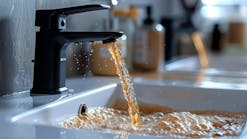This May, the Metropolitan Water Reclamation District of Greater Chicago (MWRD) invited my colleagues and I to take a tour of some of the city’s waterways, including the Chicago River’s intake at Lake Michigan and a portion of the river downtown. Among the sites along the riverfront is the Trump International Hotel & Tower, an impressive building whose gigantic name tag has been a source of controversy since its construction.
Letter height and political leanings aside, the building is currently wrapped in another controversy. A June 18, 2018, article in the Chicago Tribune noted that Trump Tower, which siphons nearly 20 million gal of water a day from the river for its cooling systems, has not kept track of whether it has taken the necessary measures to protect local fish. It also has not completed the fish kill study required by an Illinois EPA permit. Trump Tower is the only building that draws water from the river that has not filed the appropriate paperwork.
The 98-story tower’s powerful intakes draw in the river water and pump it back into the river at a higher temperature. Both the force of the intake and the temperature of the water likely are having a detrimental effect on the fish. As a comparison, a nearby 60-story building that draws 2 million gal per day has found 183 fish in its intake in the past five years, most of which were dead.
It will likely be years before the tower’s managers will be required to complete the study, as the state’s latest permit has extended the ecological study’s deadline by three years while also confirming that inspectors had not enforced the tower’s compliance with the fish-saving regulations.
Because of the state’s failure to enforce the permit, environmental groups Friends of the Chicago River and the Illinois branch of the Sierra Club are filing a lawsuit against Trump Tower’s managers for repeatedly violating the Clean Water Act.
Ironically, in 2012, tower officials paid a $46,000 fine for not securing a permit for a new cooling water intake, which the state said would “serve to deter further violations and aid in future voluntary compliance.”
Having worked with MWRD for several years, I am familiar with its mission to clean up the Chicago River and make it a swimmable, fishable recreation destination. Most of its focus is on the wastewater treatment side, and thanks to these efforts, the quality of the river has greatly improved. As the Chicago Tribune article pointed out, a diverse fish population is a sign of a healthy river, and is a strong indicator of Clean Water Act progress. That means the commercial buildings along the river have a responsibility to help protect the aquatic species that make Chicago’s waterways great.



